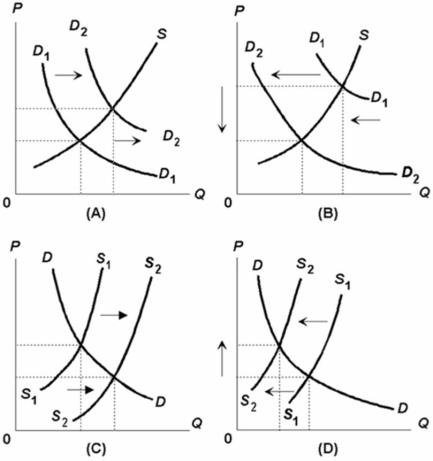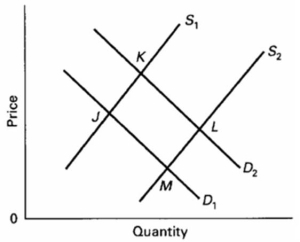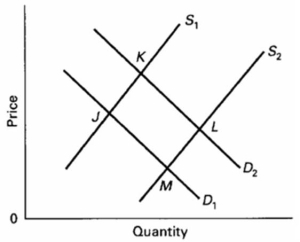A) the use of the least-cost method of production.
B) the production of the product-mix most wanted by society.
C) the full employment of all available resources.
D) production at some point inside of the production possibilities curve.
Correct Answer

verified
Correct Answer
verified
Multiple Choice
With a downward sloping demand curve and an upward sloping supply curve for a product, a decrease in resource prices will:
A) increase equilibrium price and quantity.
B) decrease equilibrium price and quantity.
C) decrease equilibrium price and increase equilibrium quantity.
D) increase equilibrium price and decrease equilibrium quantity.
Correct Answer

verified
Correct Answer
verified
True/False
A surplus indicates that the quantity demanded is greater than the quantity supplied at that price.
Correct Answer

verified
Correct Answer
verified
Multiple Choice
Suppose in each of four successive years producers sell more of their product and at lower prices.This could be explained:
A) by small annual increases in supply accompanied by large annual increases in demand.
B) in terms of a stable supply curve and increasing demand.
C) in terms of a stable demand curve and increasing supply.
D) as an exception to the law of supply.
Correct Answer

verified
Correct Answer
verified
True/False
If demand increases and supply simultaneously decreases, equilibrium price will rise.
Correct Answer

verified
Correct Answer
verified
Multiple Choice
There is a shortage in a market for a product when:
A) the increase in supply is greater than the increase in demand.
B) the increase in demand is greater than the increase in supply.
C) quantity demanded is less than quantity supplied.
D) quantity demanded is greater than quantity supplied.
Correct Answer

verified
Correct Answer
verified
Multiple Choice
Compared to the normal taxi waiting lines, Uber has:
A) shorter waiting lines.
B) longer waiting lines.
C) about the same waiting lines.
D) Finite waiting lines.
Correct Answer

verified
Correct Answer
verified
Multiple Choice
With a downward sloping demand curve and an upward sloping supply curve for a product, an increase in incomes will:
A) increase equilibrium price and quantity if the product is a normal good.
B) decrease equilibrium price and quantity if the product is a normal good.
C) have no effect on equilibrium price and quantity.
D) reduce the quantity demanded, but not shift the demand curve.
Correct Answer

verified
Correct Answer
verified
Multiple Choice
One can say with certainty that equilibrium price will decline when supply:
A) and demand both decrease.
B) increases and demand decreases.
C) decreases and demand increases.
D) and demand both increase.
Correct Answer

verified
Correct Answer
verified
Multiple Choice
 Refer to the above data.If price was initially $14, we would expect:
Refer to the above data.If price was initially $14, we would expect:
A) quantity supplied to continue to exceed quantity demanded.
B) the quantity of wheat supplied to decline as a result of the subsequent price change.
C) the quantity of wheat demanded to fall as a result of the subsequent price change.
D) the price of wheat to rise.
Correct Answer

verified
Correct Answer
verified
Multiple Choice
 Which diagram above illustrates the effect on the peanut butter market as a result of a technological advance which reduces the costs of harvesting peanuts?
Which diagram above illustrates the effect on the peanut butter market as a result of a technological advance which reduces the costs of harvesting peanuts?
A) A
B) B
C) C
D) D
Correct Answer

verified
Correct Answer
verified
Multiple Choice
If L and M are complementary goods, an increase in the price of L will result in:
A) an increase in the sales of L.
B) no change in either the price or sales of M.
C) a decrease in the sales of M.
D) an increase in the sales of M.
Correct Answer

verified
Correct Answer
verified
Multiple Choice
When economists say that the demand for a product has increased, they mean that:
A) consumers are now willing to purchase more of this product at each possible price.
B) the product has become particularly scarce for some reason.
C) the product price has fallen and as a consequence consumers are buying a larger quantity of the product.
D) the demand curve has shifted to the left.
Correct Answer

verified
Correct Answer
verified
Multiple Choice
The demand for most products varies directly with changes in consumer incomes.Such products are known as:
A) complementary goods.
B) competitive goods.
C) inferior goods.
D) normal goods.
Correct Answer

verified
Correct Answer
verified
Multiple Choice
An increase in consumer incomes will:
A) increase the demand for an inferior good.
B) increase the supply of an inferior good.
C) increase the demand for a normal good.
D) decrease the supply of a normal good.
Correct Answer

verified
Correct Answer
verified
True/False
A ceiling price in a competitive market will result in persistent surpluses of a product.
Correct Answer

verified
Correct Answer
verified
Multiple Choice
Which factor will increase the demand for a product?
A) an unfavourable report on the value of the product
B) an increase in the price of a substitute product
C) an increase in the price of a complementary product
D) a decrease in the number of buyers
Correct Answer

verified
Correct Answer
verified
Multiple Choice
 Refer to the above diagram, in which S1 and D1 represent the original supply and demand curves and S2 and D2 the new curves.In this market the indicated shift in demand may have been caused by:
Refer to the above diagram, in which S1 and D1 represent the original supply and demand curves and S2 and D2 the new curves.In this market the indicated shift in demand may have been caused by:
A) a decline in the number of buyers in the market.
B) a decline in the price of a substitute good.
C) an increase in incomes if the product is a normal good.
D) an increase in incomes if the product is an inferior good.
Correct Answer

verified
Correct Answer
verified
Multiple Choice
Refer to the graph below.The graph shows the market for a good.  Identify a correct statement about the market.
Identify a correct statement about the market.
A) The market equilibrium has shifted from point M to point K.
B) An increase in the supply of the good is more than the increase in the demand for the good.
C) The new market equilibrium price and quantity are both greater than the original market equilibrium price and quantity.
D) Point M is the new market equilibrium.
Correct Answer

verified
Correct Answer
verified
Multiple Choice
In presenting the notion of a demand curve economists presume that the most important variable in determining the quantity demanded is:
A) the price of the product itself.
B) consumer income.
C) the prices of related goods.
D) consumer tastes.
Correct Answer

verified
Correct Answer
verified
Showing 201 - 220 of 291
Related Exams